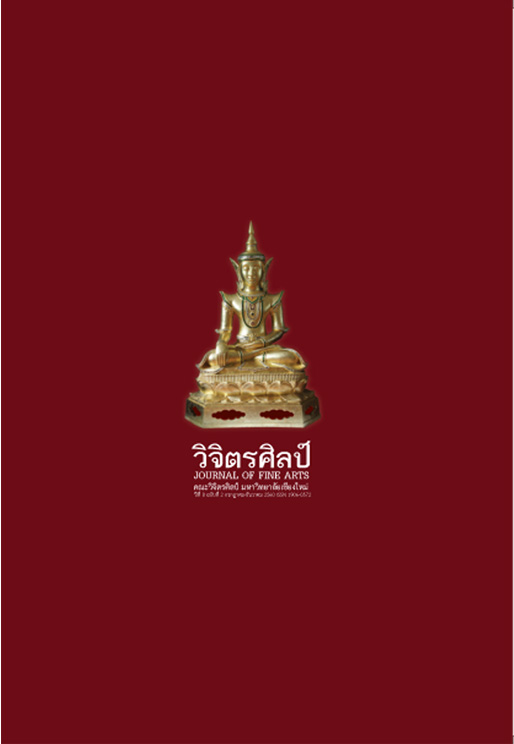การศึกษาคติการสร้างพระพุทธรูปเกสรดอกไม้ศิลปะพม่าในล้านนา เพื่อการสร้างสรรค์พระพุทธปฏิมาร่วมสมัย
Main Article Content
Abstract
งานวิจัยนี้มีวัตถุประสงค์ที่จะศึกษาถึงประวัติความเป็นมา คติความเชื่อ ประเพณีการสร้างพระพุทธรูปเกสรดอกไม้ศิลปะพม่า และศึกษาแนวคิด รูปแบบทางศิลปกรรม กรรมวิธีการสร้างพระพุทธรูปรูปเกสรดอกไม้ศิลปะพม่าที่ปรากฏในเขตวัฒนธรรมล้านนา ตลอดจนการสร้างสรรค์งานศิลปกรรม โดยการสังเคราะห์องค์ความรู้เกี่ยวกับภูมิปัญญาการสร้างพระพุทธรูปเกสรดอกไม้ศิลปะพม่าในล้านนา นำมาเป็นแรงบันดาลใจและแนวทางในการสร้างสรรค์พระพุทธปฏิมาร่วมสมัย เพื่อการอนุรักษ์และสืบสานศิลปกรรมล้านนา ผลการวิจัยพบว่า ภูมิปัญญาการสร้างพระพุทธรูปรูปเกสรดอกไม้ศิลปะพม่าที่ปรากฏในเขตวัฒนธรรมล้านนา มีความเป็นมาเชื่อมโยงสัมพันธ์กับคติความเชื่อเรื่องอานิสงส์การสร้างพระพุทธรูปด้วยเกสรดอกไม้ ที่ปรากฏอยู่ในเอกสารคัมภีร์ใบลาน และตำราการสร้างพระพุทธรูปของล้านนา ซึ่งมีเนื้อหาสะท้อนถึงวัฒนธรรมวิธีคิดในการกำหนดคุณค่าและความหมายในวัตถุอันเป็นสื่อสัญลักษณ์ของความศรัทธา ตามคติความเชื่อของชาวพุทธที่สืบทอดมาแต่เมื่อครั้งสมัยพุทธกาล จากการศึกษาแนวคิด รูปแบบและกรรมวิธีการสร้างพระพุทธรูปเกสรดอกไม้ศิลปะพม่าในล้านนา พบว่า แนวคิดในการสร้างมีที่มาจากพุทธปรัชญาแบบเถรวาท ได้แก่ แนวคิดมหาปุริสลักษณะ แนวคิดสัญลักษณ์ปางพระพุทธรูป และแนวคิดสัญลักษณ์พระอดีตพุทธเจ้า ส่วนรูปแบบทางศิลปกรรม มีทั้งแบบศิลปะพม่าสกุลช่างมัณฑเลย์ และสกุลช่างไทใหญ่ อีกทั้งยังมีกรรมวิธีการสร้างที่หลากหลาย ซึ่งสะท้อนผ่านคำเรียกขานพระพุทธรูป นอกจากนี้ ผู้วิจัยได้สังเคราะห์องค์ความรู้ที่ได้รับจากการศึกษานำมาเป็นแรงบันดาลใจและแนวทางในการสร้างสรรค์ พระพุทธปฏิมาร่วมสมัยปางโปรดพญาชมพูบดี ที่ได้รับอิทธิพลด้านประติมานวิทยาจากพระพุทธรูปสกุลช่างไทใหญ่ ด้วยดอกไม้ที่พุทธศาสนิกชนนำมาสักการบูชาพระ โดยนำกรรมวิธีการสร้างพระพุทธรูปศิลปะเครื่องเขินมาประยุกต์ใช้ในการสร้างสรรค์ ซึ่งเป็นการเชื่อมโยงภูมิปัญญาการสร้างงานพุทธศิลป์ในอดีต ไปสู่การสร้างสรรค์งานทัศนศิลป์ในปัจจุบัน ที่สามารถสะท้อนให้เห็นถึงคุณค่าและความสำคัญของภูมิปัญญาอันเป็นแก่นของวัฒนธรรม
A Study of the Principles of creating Buddha images from Pollen in Burmese Arts Found in Lan Na
This research had the objectives of studying the history and beliefs related to the convention of creating the pollen Buddha images made of pollen, as found in Burmese Arts in the northern Lanna kingdom. The study also examines the creation of contemporary Buddha images employing the same materials and techniques, with the aim of conserving and maintaining Lanna art forms as well. The study revealed that the wisdom for creating the pollen Buddha images was related to the beliefs about the merit gained from making pollen Buddha images, as they appeared in some palm leaf texts and the Lanna handbook on making Buddha images, which reflects the ways of thinking, values and meanings given to these objects of faith passed down from the Buddha’s time. From the study of the concept and art forms as well as the method of making the pollen Buddha images, it was found that the concept was derived from the Theravada Buddhist Sect in terms of the characteristics of the Great Man, the posture of the Buddha images and symbols related to the Lord Buddha. Regarding the style of art, there were those of the Burmese art of the Mandalay school and Tai Yai school, as well as various methods of Buddha image making as reflected in the names of the images. The researcher applied the knowledge synthesized in the study to be an inspiration for making a contemporary Buddha images of Lanna Buddhist art in the the preaching to Jambupati posture influenced by the iconography of the Tai Yai school from the pollen of flowers the Buddhist devotees brought to pay respect to the Buddha images. The art of lacquer ware making was employed to link the past wisdom of Buddhist art with the contemporary visual art creation. This reflects the value and significance of the local wisdom which forms the core of Lanna culture.


